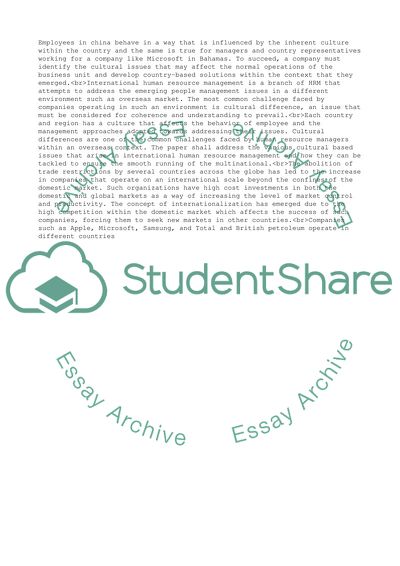Cite this document
(Cultural Challenges in Overseas Multinationals Coursework Example | Topics and Well Written Essays - 3000 words - 1, n.d.)
Cultural Challenges in Overseas Multinationals Coursework Example | Topics and Well Written Essays - 3000 words - 1. https://studentshare.org/management/1862704-what-cultural-challenges-do-multinational-corporations-face-with-people-management-in-some-overseas-locations-critically-discuss-using-illustrations-to-demonstrate-your-argument
Cultural Challenges in Overseas Multinationals Coursework Example | Topics and Well Written Essays - 3000 words - 1. https://studentshare.org/management/1862704-what-cultural-challenges-do-multinational-corporations-face-with-people-management-in-some-overseas-locations-critically-discuss-using-illustrations-to-demonstrate-your-argument
(Cultural Challenges in Overseas Multinationals Coursework Example | Topics and Well Written Essays - 3000 Words - 1)
Cultural Challenges in Overseas Multinationals Coursework Example | Topics and Well Written Essays - 3000 Words - 1. https://studentshare.org/management/1862704-what-cultural-challenges-do-multinational-corporations-face-with-people-management-in-some-overseas-locations-critically-discuss-using-illustrations-to-demonstrate-your-argument.
Cultural Challenges in Overseas Multinationals Coursework Example | Topics and Well Written Essays - 3000 Words - 1. https://studentshare.org/management/1862704-what-cultural-challenges-do-multinational-corporations-face-with-people-management-in-some-overseas-locations-critically-discuss-using-illustrations-to-demonstrate-your-argument.
“Cultural Challenges in Overseas Multinationals Coursework Example | Topics and Well Written Essays - 3000 Words - 1”. https://studentshare.org/management/1862704-what-cultural-challenges-do-multinational-corporations-face-with-people-management-in-some-overseas-locations-critically-discuss-using-illustrations-to-demonstrate-your-argument.


